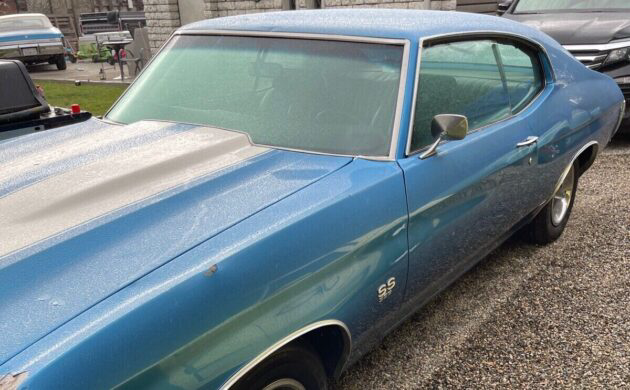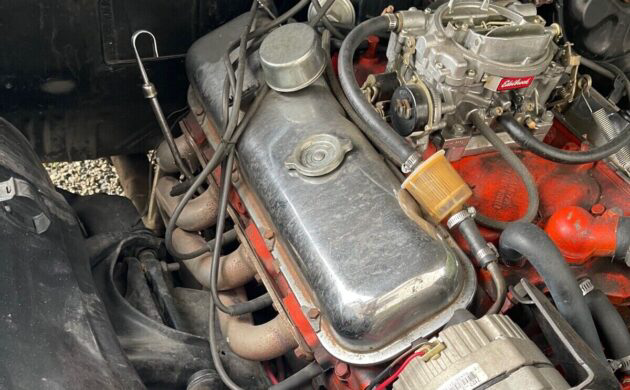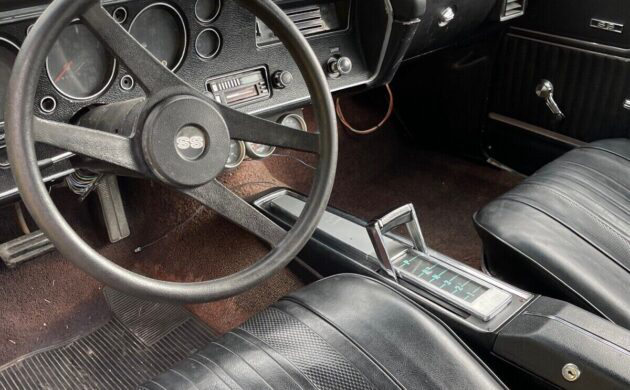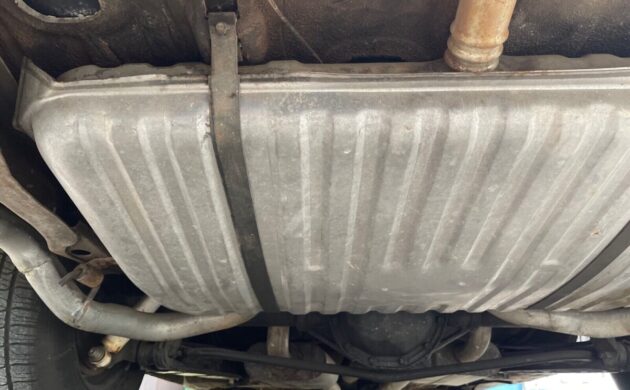Up for sale here on eBay is a 1970 Chevrolet Chevelle, bid to $25,900, reserve met. This car is located in Long Beach, California, and can be driven to its new home. Some sellers seem to be unable to photograph an entire car in one frame; this is that guy. Puzzling together the bits of the car he is able to present reveals a minor project with some rust and small dents here and there. The seller is under the impression that the VIN will tell whether this is a real SS, but that is not true past 1968. In 1969 the SS became an option package, not a model, and its tracks were erased from the VIN. Documentation is not available for this car, so the buyer’s job becomes a lot harder. Here is help. As it is, all this VIN tells us is that the car is a Malibu made in Van Nuys, California in 1970 with a V8, and the body style is a two-door sport coupe. After that, you’ll be crawling in the dirt and getting greasy to prove it’s an SS.
According to the seller, this motor is a 396 cu. in. V8, which incidentally would come in the SS package but also came in a plain vanilla Malibu. Only the motor code would tell us if this is the L34 or L78 – the compression ratio making the difference between a measly 350 bhp or 375. Seriously, either motor was a great option for this true muscle car – the 396 would help the Chevelle make tracks to 60 mph in 8.5 seconds. This car has a three-speed automatic transmission with a horseshoe console shifter. The seller says he has been using this car as a daily driver and it’s had all its fluids changed recently.
A new dash pad is either installed or coming with the car; other than some fading the interior isn’t in bad shape. The brown carpet is puzzling; if this car was blue from the factory the interior was either medium blue, black, ivory, or red (matched with Fathom Blue). The SS logo is present on the steering wheel (and we see SS emblems on the exterior) but of course, this and other features of the SS can be installed fairly easily to hoodwink the unsuspecting. The seller also has an OEM cowl induction hood for the car; it’s unclear if that is also included in the sale.
The underside shots reveal that despite the rust here and there topside, this Chevelle does not fall into the “donor only” category. It is much better than that. Regarding value, a documented SS can sell for $90,000 or more; a run-of-the-mill restored Malibu will be in the $55,000 area. Gauging the bid price against the photos supplied – without talking to the seller – it feels like this car is undervalued so far even if it’s not an SS. What do you think?






Michelle, faded black is the carpet color.
The car does show promise as a real SS due to the instrument cluster and the
12 bolt differential.
I’d venture to make a closer look at this price point it might be a “decent” deal.
12 bolt and rear sway bar I think is F41 option maybe available without SS. But definitely F41.
I had a true 70 SS. This is not one.
Every body here had a true 70 SS Chevelle
Michelle Rand’s link HELP above is some fine reading…
Make your own conclusion, OR,
Howard will tell you if it is real.
Not being able to see front markers and the fact it don’t have a cowl hood. Tells me. It’s a Malibu package SS. With some mods done to it.
And the fash and steering wheel appear to be from a 71.
It looks like a Camaro steering wheel 70 to 81
How can you be so sure? I’d pull the tank & back seat & try & find the build sheet.
well we know only SS model came with SS dash pretty hard to dispute that FACT.u cud get the SS model many diff.ways from factory.but u cud not get SS model with a Malibu gauge cluster.so that’s how I rate a Chevelle if I buy 1 which I did several yrs ago.that 1 had buckets but someone traded out the column shifter for the floor shifter but left the column shifter on car.that does not mean it wasn’t ss model
I wouldn’t base my judgement on a Chevelle being a SS just by the dash, they are not difficult to swap out, and the dash on this car appears to be from a 1971. It does appear to be a legitimate GM dash as opposed to an aftermarket piece. There are SS specific items to look for as well, the F41 suspension, correct size fuel lines, the big-block specific steering shaft and coupler, things like that aren’t always addressed when cloning a car. Paint, stripes, and trim alone do not make a Super Sport. At the end of the day, none of this matters, build a great car and enjoy it, but never try to pass it off as an original unless you have documented proof.
looks like a 10 bolt rear
It’s a 12 bolt. A 10bolt would have only one bolt on the bottom of the cover.
71-71 steering wheel and missing heater box on firewall. Needs closer inspection!
No way thats like a 74 wheel used in many other models. 70 wheel be one bar across center. that wheel never left the factory in a Chevelle. SS emblems were recessed into most applicable interior parts. I think that’s actually a C10 pickup SS454 wheel.
Michelle, that’s a Bread Basket shifter, and about as cool as can be. Not SS proof. No 396 option in 70 reality – the 396 was bored our to a 402ci 70 on. Car has SS door panels, means just that. That rust is typical in that spot. That’s an SS cowl hood – cowl induction is quite the multi part foam sealed upgrade. I’ve never seen a non SS big block production Chevelle, be super rare. Should have a turbohydromatic 400 transmission, the pan isn’t square, the turbo 350 is.
You are WRONG. There were NO SS 402 optioned Chevelles offered in 1970. You could only buy an SS 396. Everyone already knows the difference in bore size in a 69 396 and a 70 396. All 1970 Chevelles were offered with the SS 396 option or the SS 454 option, period. Maybe you can show us some of those 70 SS cars with 402 on the fender.
The SS396 badge was never changed by Chevy due to it’s recognition and popularity but Douglas is correct. As of 1970 the SS396 badged cars were actually bored .030 over to 402ci.
You need to read some Chevy books. The 396 became 402 c.i. in 1970, they did not change the badging on the cars, nor the marketing for them.
Jeez, maybe J and DBW31 should have read my entire reply, especially what I said about the bore size. EVERYONE already knows the difference. Now guys, show me the literature on a 1970 SS 402 Chevelle. Show me where they were offered as SS 402’s instead of SS 396’s. D.H. says there was no SS 396 option offered in 1970. I disagree. For everyone’s information, every 70 was offered with either a 396 option or a 454 option. End of conversation. Show something saying different. As far as reading some GM literature on Chevelles, I would bet that I have forgotten more than some of you guys will ever know. I’ve owned over 20 69 and 70 SS Chevelles since 1975 and one COPO. I don’t need to read the books when I helped write most of them. Show me that SS 402 literature and I will eat crow.
They didn’t advertise the 402, but the 396 was actually bored .030, I’ve been around these cars since they were 4 years old and being hammered.
From: Chevelle Stuff The Chevell Authority
Home
1964
1965
1966
1967
1968
1969
1970
1971
1972
Misc.
What’s New
Decode
Tech
Tools
FAQ
Dale’s Coins/CDs
Contact
Mac’s Registries for Chevelle/Camaro/Nova/HHR
Chevelle of the Month
Things For Sale
Zone & Dealer Numbers
Trim Tag Decode
Custom Stickers
1970 Chevelle Engine Photos & 396/454 cid Engine Production Numbers
[ 1965 ] | [ 1966 ] | [ 1967 ] | [ 1968 ] | [ 1969 ] | [ 1970 ] | [ 1971 ] | [ 1972 ]
1970 396/454 Engine Production
The ‘396’ L34 & L78 engines were actually 402 cubic inches in 1970. The L34/L78 & L89 aluminum head option on the L78 figures are for Chevelle (“A” body), Camaro (“F” body), and Nova (“X” body) platforms and are broken down as such.
The LS3 is a 402 cid Mark IV engine listed as a Turbo-Jet 400 and was available on all factory V8 wagons, the standard Chevelle series sport coupe and pickup, and all Malibu series body styles including the Custom El Camino that were NOT SS optioned. The LS3 was not available when the Z25 SS 396 equipment option was ordered. The LS3 was identified with ‘400’ emblems on the front fenders in the same manner as the ‘350’ and ‘307’ emblems.
You say, and I quote: no 396 option in 70. Then you show figures that say 396/454 for 70. Everyone knows the difference in size between 69 and 70 396 engines, EVERYONE. Yet some people want to show how smart they are by saying a 70 SS 396 is not really a 396, it is really a 402. Everyone already knows that!!!!!! That being said, it is still optioned and advertised and sold as an SS 396, which you say was not offered as an option in 70. If you cannot show us the factory option number listing a 402 instead of a 396, then I guess you are wrong. We are not talking about stickers, we are talking about options and option numbers. IF 70 Chevelles were only offered as SS 402’s as you say, then you should easily be able to show the GM ads saying: come on in and buy your new SS 402 Chevelle, today. Also show a build sheet or window sticker listing 402 as the engine option. Should be easy enough. Maybe I’m wrong and literature and ads did call them SS 402’s. This idiotic conversation all started because you say they did not offer a 396 option in 70. I still believe they were called 396 Super Sports, regardless of engine bore and size. Show the 402 option listing and you win. Show us something we don’t already know.
Interesting! This is the first time I have ever heard the shifter referred to as a Bread Basket shifter, I’ve heard them referred to as a horse shoe and staple shifter. Maybe different parts of the country called them that?
alot more than compression ratio for 350hp to 375hp….heads, cam, lifters, intake, carburetor, timing……js
well we know only SS model came with SS dash pretty hard to dispute that FACT.u cud get the SS model many diff.ways from factory.but u cud not get SS model with a Malibu gauge cluster.so that’s how I rate a Chevelle if I buy 1 which I did several yrs ago.that 1 had buckets but someone traded out the column shifter for the floor shifter but left the column shifter on car.that does not mean it wasn’t ss model
This appears to be an L34 with the 948 cast iron oval port spread bore intake.
It looks like a Camaro steering wheel 70 to 81
Malibu did not have round gouges. Only SS models.
The optional U14 instrumentation was available as an option on non-SS cars. Another indicator of an SS car is it has a different intermediate steering shaft…
This is a real SS,period.beat up badly and a lot of Bondo,it’s a SS hood without cowl induction everything else says SS
How do u contact to look or buy?
No build sheet, no guarantee it’s an SS! A savvy builder can take a plain-jane Chevelle and equip it with all the right stuff. That being said, this one bares all the right stuff and looks the part. Yes, the steering wheel is incorrect and that missing heater box should be a yellow flag at least only because it indicates some funny business when on during this car’s life. The owner would be smart to pull this auction, find a build sheet, and re-list it. Oh yeah, and the layer of bondo… gag.
I had a 70 SS396 (bought new) and later in life, a 70 El Camino SS396 (bought new by BIL), and I don’t remember that ugly as5 steering wheel on either of them. And as far as the owner’s “OEM cowl induction hood”, that doesn’t mean the car CAME with it. And I’ve seen more restored cars with the cowl hood but NOT the cowl induction air package, and this thing has enough inconsistencies that I question just how “SS” it really is. But that will have NO bearing on how much you smile when you’re driving it down the road, and reminiscing of those Wednesday nights on Van Nuys Blvd. And remember just how BAD your car sounded full throttle WITHOUT an air cleaner? Most of us have a few replacement parts, why can’t our car?
Yup redo this listing with Much better pic’s.
It wouldn’t be easy to find a real SS rear bumper with the rubber pad insert. Not definitive proof, but at least another sign this might be the real deal. I restored an early 70 SS 454 in the mid-80’s, and reattaching that pad to a rechromed bumper took some research between me and a Chevelle restoration parts supplier to determine how the supplier did it.
looks like a 70’s Camaro steering wheel
A lot of things can change on a car in 53 years including the dash, dash pad, upholstery, door panels (not “cards”), steering wheel, etc. As is the case with this one. There ain’t anything left that’s original, and it’s already needing a second restoration, so why worry about authenticity? None of what’s shown is positively indicative of how the car left the factory although the boxed control arms make it plausible it’s an SS. Build sheet(s) will absolutely confirm if this is a ZL3/Z25 car or not, but so many monkey see, monkey do’s are Hellbent on scouring for and removing all traces of build sheets that have been safely entombed for 50 years, it’s tantamount to desecration. Once removed, they’re easily separated from their rightful car. So, if you happen to have an original build sheet in your rear seat springs or whatever, try photographing it and leaving it alone already, Sparky! Resist your TV barn-finder guy tomb raider urges and leave it as found. You don’t have to be like all the other trendy sheeple, do you? Carrying around your crusty build sheet in a fake woodgrain Chinese picture frame from Walmart.
If this car had miraculously started life as a Malibu 400 – which is very unlikely – it would’ve had a milder LS3 402 rated at 330hp. These were very low production and rare as hens teeth. Anyone who converts one to an SS 396 at this point is a fool. But then again, look at people nowadays. This particular car is a garden variety previously restored indeterminate Chevelle needing a second restoration. No limits to what you can do with it as long as you don’t spend too much up front. It’ll never be what it was again and without a build sheet, proving what it was will be difficult without at least a matching stamp on the engine block which almost certainly has been decked. Smart money buys the beautiful ’74 LT Z28 survivor listed elsewhere and foregoes all the mental gymnastics and wallet draining. It’s just about as quick, too.
I know the car in question is a ‘70 but I factory ordered a ‘71 Malibu that was pretty much an SS without the SS package. IIRC the color was Mulsane blue, black buckets, SS gage package (as said above that was available without the SS option) the Turbo-Jet 400 engine with Turbo 400, posi, F-41, black walls and dog dish hub caps.
‘71 had two 400 engines, the Turbo-Jet 400 which was the 402 rated at 300 hp and the Turbo-Fire 400 small block. Both were badged 400 on the fender.
I never thought about the car being particularly rare, sounds like one I should have kept.
Deuce guy just described a car I just sold. Except the color was Rosewood. Had all the SS options. The car was pretty rusty but the engine was a 402 & the # was in the vin.
Will make a very nice car.
Someone in Oklahoma bought it. If you read this I still have some parts.
They didn’t advertise the 402, but the 396 was actually bored .030, I’ve been around these cars since they were 4 years old and being hammered.
EVERYONE knows that sir. As you say, they didn’t advertise a 402 option. They DID advertise an SS 396 option, regardless of what it actually was. Since no one else can show us, maybe you can show us some GM advertisement for an SS 402 Chevelle.
No one ever said that you could not get the SS396 option in 1970, but rather that you could not get a 396 c.i. engine, as it had been changed to a 402. Caw, caw.
To my friend Albert (DBW31). Please read the comment from DH. I think it is the 11th comment on this post. Please write down the first 4 words in the third sentence of Mr. H’s comment. No discussion, just write down those words. I’m curious what he said. Maybe I did misread it. Thanks, Albert.
I’m sorry DBW31. Did you post copies of the Chevrolet literature showing the New for 70, Chevelle SS 402 that they showed prospective buyers.
How do you tell if a 1970 Chevelle is a true SS?
The instrumentation on 1970 models used numerals that had a greenish hue, and 1971 and 1972 models were white. The steering column and gauge area is always black on all SS models. The round-gauge-type SS dash was also used in Malibu models when the RPO U14 option was added.
Chevrolet made the decision to bore the 396 in about March of 1969 solely for the purpose of circumventing some of the federal emission standards, as the requirements for engines less than 400 cubic inches were more stringent and would have added more expense to the cost of the engine and a reduction in performance. So a very simple solution as far as the 396 engine was to bore the block .030 and install .030 pistons making a 402 cubic inch engine there by skirting the federal emission standards for an engine of less than 400 cubic inches. So the 1969 late year and the 1970 Chevelles and impalas and Camaros and Novas and anything that Chevrolet installed the 396 engine in during that time was actually a 402 cubic inch engine, however Chevrolet never changed the badging or decals from the 396 as it was a recognized piece and why go to the expense ? As Chevrolet had decided to end the 396-402 run after the 1970 model year. Not rocket science, GM Chevrolet virtually had very minimal cost to bore the blocks an additional.030 and very minimal expense to buy .030 pistons to get around the Federal emissions standards. Nothing too confusing and all party’s were happy.
454Rat, “Show me that SS 402 literature” Never advertised as a SS402, as a SS396. Did you even bother to read the emissions stickers that were under the hood of all of the cars that you owned?
454Rat said 69/70… I can tell you that there is no mention of 402 CID on a 1970 emissions sticker, however, yes on a 71-72 sticker. My 1970 El Camino SS 396 only refers to the HP and idle settings. That said, an emissions sticker is far from what I or most enthusiasts would consider literature…
Without a doubt this is the feistiest thread EVER on BF. Jon McKenzie explains it best.
Where is HOWARD???
If I were guessing, I would say he is shaking his head and saying: are these people really this stupid. Then again, he may own a 70 SS Chevelle and he has had a nervous breakdown trying to figure what engine it really has in it. LOL Okay people. Enough foolishness. Let the man sell his car.
Absolutely, positively the wrong steering wheel for a 1970 SS Chevelle. Those came on the 1971 and up Chevy Vega GT. That SS in the horn button could have come from almost any dealership, just to put one in. When so many questions about the validity of a vehicle come about, you have to ask yourself if you want to take a pricey chance or not. The Vin numbers will tell you a little bit about the car.
All I have to say about this is, I wish the new owner the best of luck that the car is a true blue Super Sport, SS!
Also Never heard “bread basket” shifter.
People just made up their own names for these things. Some call them horseshoe shifters. They were simply an attempt at improving passenger safety. Designed not to impale the driver and the almost certainly airborne passengers in the event of a collision. They got rid of the Stik-Shift on lightweight Schwinn Fastback bicycles under the same logic, replacing it with conventional handlebar gear control in ’74 I think.
Glen, good eye on that intake..